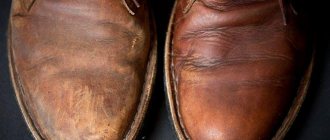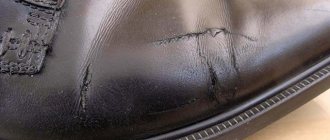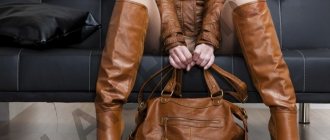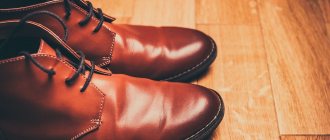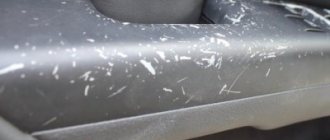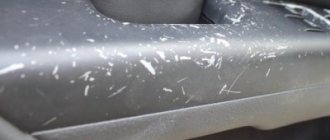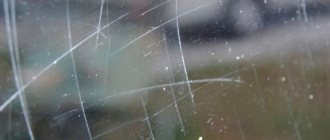If in past years sneakers were shoes exclusively for sports, now they are worn everywhere.
Active use of the pair leads to rapid wear, the first sign of which is creases.
Read the article on how to remove creases from sneakers made of leather, leatherette and nubuck, as well as how to prevent these defects from appearing.
How to remove creases from leather sneakers?
It is best if the shoes are made of leather. It can be restored more quickly, and natural material does not wrinkle as easily. Inexpensive Chinese eco-leather cannot boast of excellent quality, so such shoes very quickly become unusable. Most often, creases appear on hard calfskin, as well as on leatherette. On soft skin, creases appear more slowly and are quickly smoothed out due to the structure of the material. You shouldn’t get upset; you need to try to level the surface.
How to remove creases from leather sneakers:
- The method is suitable exclusively for leather shoes. Under no circumstances should it be used on shoes made of artificial materials, as this will lead to damage and bald spots. At the initial stage, you need to fill the sneaker with a large amount of fabric or paper. Please note that you should not choose newspapers for filling. The ideal option is white cloth or paper.
- When exposed to high temperatures, paint from newspapers can be imprinted on the inner surface of the shoe. It is necessary to make a frame from cardboard and place it in the area of the toe and tongue. It is necessary that the inner part fills the shoe tightly, resembling a foot. You need to take a damp towel and place it on the ironing board. The surface of the sneaker is covered with a white cloth and a damp towel.
- Turn the iron on to steam mode and go over the creases several times, which have been smoothed out thanks to the fabric inside the shoe. Never remove white paper or fabric immediately. Allow the shoes to cool completely. Leave it for about two hours. After this, remove the fabric and evaluate the result. Remember that you should not overheat the iron so as not to damage the leather.
Shoe glue: brands for various materials
Wondering which adhesive is best for shoes made of a certain material? Let's take a look at the rating of high-quality special compounds for reliable bonding.
- KENDA FARBEN is a good shoe glue from an Italian manufacturer. It is considered universal and is excellent for gluing synthetic and natural leather. Copes with rubber, textile, wood, plastic, shotgun and metal products. It is often used by craftsmen when repairing boots, because the materials adhere quickly, and the seam is durable and moisture-resistant.
- UHU “SCHUH & LEDER” - this glue is actively used by shoemakers for gluing hard and soft materials. The seam has been characterized by increased elasticity for a long time. Resistantly withstands the negative effects of moisture, alkali and acid. It does not dry out for a long time and can withstand high and low temperatures. If the sole has burst, then using Uhu glue you can glue the separated parts together using the contact method. Use solvent reactivation or heat activation.
- Use professional EVA glue if you don’t know how to seal a hole in your shoes. It reliably connects corner and side cuts, porous surfaces of breaks. In addition, they can be used to glue the insole. This is a reliable waterproof product that does not flow under the influence of ultraviolet radiation and does not leave adhesive marks. Suitable for all types of materials except PVC.
- You can glue the polyurethane sole with Nairit Shoemaker. It is actively used in their work not only by shoemakers, but also by ordinary people. It has high strength and water resistance. Does not contain hazardous substances, therefore completely harmless to humans.
- Russian-made Contact glue has been popular for more than 10 years. This product is suitable for repairing leather, rubber, ceramic and porcelain products. With its help, it is possible to fill all the cracks and gaps. If we glue even heavily damaged parts, the seams will be almost invisible.
- The Henkel company suggests using Moment Marathon for repairing boots. This is a universal adhesive that is highly effective. Economical in consumption and convenient to use. It has fast adhesion and will only take a few hours to completely harden.
How to remove cracks from sneakers?
Please note that before the procedure it is recommended to thoroughly clean the shoes from dust and wash them with detergent. Often not only creases, but also small cracks appear on the surface. This happens with sneakers made of thin leather that is used intensively. To deal with small cracks, you can use a product called “liquid leather”. This is a special substance based on oils and paraffin that seals cracks and minor damage.
How to remove cracks from sneakers:
- At the initial stage, you need to moisten the sponge with soap and thoroughly wash your shoes. Dry it, the surface should be completely dry. Sandpaper purchased at a hardware store must be used to process the crack in order to exfoliate small particles that will soon come off. Choose fine-grit sandpaper to prevent scratches and large damage.
- After this, apply liquid leather to the surface, after removing the resulting dust and debris from the leather, wipe with a sponge moistened with alcohol. This will help degrease the surface and make it completely dry. Degreasing promotes better adhesion of the regenerating agent to the surface. After the alcohol has completely evaporated, apply a small layer of liquid leather to the crack and let it dry.
- The main task is to choose a product that matches the color of the shoes. Therefore, difficulties may arise if the shoes are made of leather of a non-standard color and can be dyed. In this case, you cannot do without the help of a specialist. If the crack is still visible, you can repeat the procedure. You can layer the liquid skin several times until you get the desired result.
Alignment of creases
How to remove scratches on white sneakers?
Any solvent will help deal with dark scratches on light-colored sneakers. Make sure that it is not too aggressive and does not damage the surface of the skin. It is best if it is alcohol or nail polish remover without acetone.
How to remove scratches on white sneakers:
- Dark scratches are caused by dirt, which is layered as a result of contact with moisture, dust and grease. Such scratches are usually easily removed using solvents. Some white sneakers may turn yellow from this exposure, so immediately after using white spirit or nail polish remover, use an alcohol sponge to remove any remaining solvent. It is best to choose products without added fragrances, oils and dyes.
- Now Converse and white sneakers are in fashion, which go well with tracksuits and chiffon dresses. They can complement both sportswear and romantic looks for dates. The main disadvantage is that they quickly become covered with dust, and even with careful care they can change their color and turn yellow. Thorough washing with detergents does not always help.
- Therefore, you can use special care products. Not long ago, a special white paint for sneakers went on sale. It is created on the basis of beeswax, with the addition of pigments to disguise minor imperfections. To clean the yellow sole and remove scratches, you should use a special eraser. But as practice shows, a regular eraser for school purposes also works well. Choose a white elastic band.
- If there are deep scratches, you can purchase an eraser with a hard surface interspersed with abrasive particles. They easily remove even deep scratches and stains. There is also a special eraser for sneakers on sale. You can use it to remove black scratches from white shoes and soles.
What can I do to prevent wrinkles on my shoes?
How to minimize creases?
- Select shoes correctly according to size, fit and fit (and don’t be shy about returning shoes to the store that fit you poorly or mediocre).
- Buy boots made from high-quality leather from reliable manufacturers - not too hard and not too soft.
Interesting materials:
Where are the font files located? Where are my files? Where are the downloaded files? Where is the android update file? Where is the file located in Word 2007? Where is the file tab in Excel? Where can I view downloaded files on Android? Where are the downloaded files on Android? Where are the files saved after downloading? How to archive files in RAR?
How to remove creases from leatherette sneakers?
Faux leather is made from synthetic fibers and polymers. When heated, these materials melt and deform. Therefore, it is not recommended to iron such products even through a damp cloth. It is unknown how the polymer will behave. Usually on outerwear and skirts made of leatherette there are labels that indicate the washing and ironing mode of the products. However, shoes most often do not have such markings. Therefore, it is not clear how the leatherette will behave and what kind of fibers were used in its manufacture.
How to remove creases from leatherette sneakers:
- The best option is to do the manipulations without heating. To do this, you need to stuff your shoes with newspapers so that all the creases and folds are evened out. After this, the shoes are thoroughly washed and dried.
- After the surface becomes dry, it is necessary to apply a moisturizer with a large amount of fat. This can be either a leather cream or a special shoe cream. Try to choose beeswax-free products that are rich in fat. Products with dyes are also not suitable, as they can aggravate the problem.
- After application, thoroughly rub the product into the surface and leave until completely dry. After this, repeat the manipulation. All this time, you should not remove newspapers and paper from the sneakers; it is necessary to keep the leather substitute in a taut state.
- You can use a hairdryer. To do this, shoes are thoroughly cleaned of dirt, wiped with a damp cloth, and filled with a damp towel. Next, you need to moisten the surface of the artificial leather with water from a spray bottle and dry it with a hairdryer at medium temperature.
- It is necessary that the distance from the shoes to the hair dryer is approximately 20 cm. Under no circumstances place the hair dryer close to the creases so as not to damage the surface of the material.
Converse
Types of glue that are often used for shoe repair
Before answering the question of how to glue boots, you need to decide which sole glue will be better in a particular situation. Manufacturers offer a wide range of high-quality products, thanks to which you can easily and reliably repair any defect. What glue should I use to glue damaged shoes?
- Desmokol is a transparent polyurethane-based option recommended for gluing PVC, suede and leather elements. Professionals have already proven its reliability and actively use it in their work.
- Adhesive Moment was created specifically for eliminating defects on boots, boots and other wardrobe items. Moment for shoes is a water- and frost-resistant product that will allow you to securely fix the main element. It withstands the negative effects of the environment. However, it is not suitable for gluing products made of polyethylene, polypropylene and styrofoam. It is often used as glue for repairing shoes at home, because it is available for purchase at any household store. Within a day after gluing, you can put on your boots.
- Epoxy resin . This is the optimal composition that will help glue a broken sole. After all, after hardening, it turns into an elastic layer that does not allow moisture to pass through. However, the hardening process is quite long. If we glue shoes with it, we need to wait until it hardens completely, and this can take up to two days.
- Shoemaker. It contains rubber, organic solvents and special adhesive enhancers. Designed for gluing shoes, because it reliably fixes the rubber sole and leather upper. It can also be used to glue linings and insoles.
- Bonikol . A unique composition created specifically for shoe factories and workshops. Benicol provides reliable adhesion of all elements made of various materials.
It is worth noting that the well-known PVA glue and superglue, contrary to the opinion of many, are strictly forbidden to be used for restoring footwear. These products are intended for fixing completely different materials, and therefore do not provide reliable gluing of holes and the bottom of the shoe. Moreover, these substances can cause irreparable harm to your boots.
Why do creases appear on sneakers?
Buyers often blame manufacturers for the appearance of creases in shoes because they use low-quality material. However, in reality this is not the case. Most often, it is not the properties of the material that contribute to the appearance of creases, but the correctness of wear. In order for shoes to last longer, you need to carefully care for them and perform simple manipulations. The main problem is that they try to dry winter shoes, which often come into contact with snow and mud, as quickly as possible. Therefore, they are placed near heating radiators and heaters. This should never be done, as leather shoes dry out like the epidermis on the face. As a result of this, it becomes all the more rough, creases and folds appear. Therefore, it is necessary to ensure sufficient hydration and care.
Why creases appear on sneakers:
- After returning from a walk after rain, it is recommended to wipe your shoes dry and apply moisturizer to the surface. This can be either a face cream or special shoe care products. This must be done until a greasy sheen begins to remain on the surface and the product ceases to be completely absorbed. This means that the material is completely saturated with moisture and sufficiently moisturized.
- In addition, improperly selected shoes contribute to the appearance of creases in its folds. It has been proven that most often folds appear on shoes that are not selected in size and width. This often happens to thin people and people who have low arches and very narrow feet. As a result, even standard shoes of the right size remain quite wide and loose. In this case, creases cannot be avoided. It is necessary to have custom-made shoes or wear thick socks to compensate for the lack of fullness in the feet. Wrinkles can appear on shoes that are over-stretched if the foot is too wide.
- Most often, shoes with one seam at the back, cut from a single piece of leather, are susceptible to creases and folds. It is very difficult to achieve the necessary relief and shape inherent in the shape of the leg with one piece of skin without cuts and seams. These shoes are of very high quality and are expensive, but creases and folds appear most quickly on them. Therefore, when purchasing such an accessory, you need to take care of hydration.
Why does this happen?
- The most common option is poor quality shoes. If the materials from which the shoes were made are of very low quality, then the shoes will quickly wear out at all places where they are folded.
- Health. About 80% of the population have various types of foot deformities to one degree or another. In accordance with the characteristics of gait, overload zones appear in the areas of “shifts” of the pressure curve, and at a certain age, corns form. The skin of the outer edge of the heel, the forefoot, and the inner edge of the big toe are especially affected. This is where excessive shoe wear occurs. Most often, excessive shoe wear causes flat feet. With this disease, a person simply cannot place his foot correctly and evenly, as a result of which the shoes quickly lose their shape and wear out. The same goes for the heel. If the shoe itself is severely deformed, then the heel begins to wear out.
- Influence of type of activity. Many dancers who wear professional dance shoes complain that even expensive ballet shoes wear out quickly. The reason here is that dancers have too much mobility in their feet. Even when walking normally, they arch their foot, causing the heel to rub. But most often car drivers face this problem. When you constantly press the gas brake pedal, the heel rubs against the plastic. To avoid this, you just need to drive the car more carefully and watch where your foot is positioned on the pedals. If you can’t do this, then special “overlays” for shoes are sold for such cases. They are easy to put on any shoe. Made from a variety of materials and colors, this type of “shoe” for your shoes will protect them and extend their lifespan.
How to remove creases from suede sneakers?
Sneakers made from natural suede wear very well, especially if you care for them properly. They do not tolerate wet weather or walking through puddles. In this case, they must be dried immediately and treated with a special soft brush to lift the villi.
How to remove creases from suede sneakers:
- You can disguise defects on suede sneakers using a brush with small bristles. To eliminate minor damage, use a school eraser. It is necessary to walk it over the surface of the shoe.
- On sale you can find special paint in a spray bottle and apply it to shoes after preliminary cleaning and drying. You can also remove scratches with black bread. To do this, rub the damaged areas with a crust of bread.
Recovery
How to remove creases from white sneakers?
To remove grass stains and dark-colored scratches from light-colored sneakers, you can use gasoline or tooth powder. If these are leather sneakers, then it is best to moisten the surface of the sponge with milk or olive oil and rub the mark.
How to remove creases from white sneakers:
- Damage can be repaired using a liquid corrector. However, this is the best option for inexpensive Chinese shoes. If you are resuscitating natural leather sneakers, it is better not to use a corrector, as it will ruin them.
- To disguise dark scratches that could not be removed with solvent, you can use white paint in the form of a spray or cream. However, the cost of such a product is quite high.
- If there are deep scratches on white sneakers, it is best to use white varnish or gel polish for these purposes, which must be dried in an ultraviolet lamp and then wiped with a degreaser. This will hide imperfections. But if the scratch is in an area of constant bending and wrinkling, the varnish will soon peel off.
How to remove cracks on the soles of sneakers?
It is not easy to restore the sole if cracks appear on it. However, it is still possible to do this at home. The simplest option is to use Moment glue or epoxy resin, which is sold for gluing car parts. To do this, you need to bend the sole in half so that the ends of the crack become visible.
How to remove cracks on the soles of sneakers:
- It is necessary to scrape off dirt, debris, and remove contaminated areas using a shoe knife. After this, sandpaper is applied and the surface is degreased. Next, a thick layer of glue is applied, the edges are connected to each other.
- Such shoes must be placed under a press or a heavy object for a day. Using a knife, you need to mark zigzag lines that will connect the two parts of the sole. Using a shoe hook and thread, you need to connect the edges of the sole. This way you get double protection: gluing with epoxy resin and seam.
- You can restore the sole using nylon and a soldering iron. It is necessary to degrease the surface, remove debris, and then wipe the cracks with sandpaper. After this, you need to heat up the soldering iron and melt the material along the crack line on both sides. Next, a piece of nylon is inserted, which is melted using a soldering iron. The molten mass must be pressed into the resulting space using the handle of a soldering iron, not the spout. The spout is hot, so dents will form.
Repair
Read on topic:
- Shoes squeak when walking: what to do?
- How to clean boots from white stains: tips
- How to stretch and break in shoes: tips
- How and with what to remove fuel oil from the surface of sneakers, shoes, and boots?
- Slippery soles of boots: what to do?
Experts recommend purchasing not one pair of shoes for the season, but two or three, in order to alternate them with each other. It is recommended to store winter shoes not in plastic bags, but in cardboard boxes, stuffing them with fabric or paper. This helps smooth out folds and prevents creases from appearing. Before storing a winter pair, you must thoroughly clean it with a thick layer of paper or cloth, and apply a large amount of a high-fat care product on top. After a few months of storage in the closet, such shoes are completely smoothed out and ready for subsequent wear. The best option for storing shoes is cardboard boxes with ventilation.
DIY tread repair
The most vulnerable are the protectors located on the heels of shoes. To restore them, you will need a hard piece of rubber, which can be taken from the sole of unnecessary shoes. Among the tools and additional devices that will be useful for work are: shoe glue, a sharp knife, and coarse sandpaper. The tread repair process is as follows:
- A patch is cut out of a piece of hard rubber and fitted in place of the damaged or worn out tread.
- Using a knife and sandpaper, make a wedge-shaped patch.
- The surfaces that will be glued are treated with sandpaper to roughen them, and then wiped with a solvent and allowed to dry.
- The adhesive composition is applied in two layers to the patch and the future location of the protector. The drying time of the first layer should be about 20 minutes, the second - 4-6 hours.
- After the glue has dried, the surfaces are heated over the stove until a smell appears, applied to each other, squeezed tightly and held until cool and fixed.
